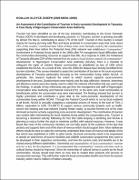| dc.description.abstract | KOILLAH ALOYCE JOSEPH (2009-MO91-10006)
An Assessment of the Contribution of Tourism in Socio-economic Development in Tanzania: A Case Study of Ngorongoro Conservation Area Authority
Tourism has been identified as one of the key industries contributing to the Gross Domestic Product (GDP) of developed and developing countries. In Tanzania, tourism is growing annually by almost 5% that is, contributing to about 17% of the GDP. Tourism in this country is known mainly for having stunning wild flora and fauna protected in conservation areas that cover about 28% of the country‟s territorial land. Most of these areas were formally used by the communities supporting their lives before the Protected Area (PA) network was established. Communities‟ involvement in Protected Areas started in the 1990s after PA management faced difficulties with the communities demanding resources to support their life. As a response in 1995, the Parliament of Tanzania allocated 25% of the revenue from the parks to local district councils for communities‟ development. In Ngorongoro Conservation Area Authority (NCAA), there is a mandate to safeguard the rights of resident Maasai communities as established by law of 1959 which established the NCAA. As a result of this, since the 1990s the Maasai have directly benefited from tourism activities. This survey intended to assess the contribution of tourism in the socio-economic development of Tanzania particularly focusing on the communities living within NCAA. In particular, this research explored the extent to which tourism supports socio-economic development in the area. Questionnaires were mainly used for data collection; however, interviews and literature review were also deeply used to collect the relevant information that was used to get the findings. A sample of key informants was got from the management and staff of Ngorongoro Conservation Area Authority and Pastoral Council (PC). In the same vein, local communities as beneficiaries within the conservation area were interviewed. The findings showed that tourism is highly prioritised and contributes a great deal to the socio-economic development of the communities living within NCAA. Through the Pastoral Council which is run by local residents at all levels, NCAA is annually budgeting a substantial amount of money to the tune of TShs 1 billion, equivalent to USD 714,285.72 to support various community projects such as health, school, bee keeping and road network (mainly feeder roads), as tourism formed one of the main dominant economic activity supporting socio-economic development. The contribution of tourism was evident after interviewing the local residents living within the conservation area. Tourism is becoming a dominant activity following the fact that cattle keeping is declining and NCAA is planning to reduce further the stock to minimise conflict with natural resources. However, it was found that most of the community members are not fully aware of the existence of the law that protects and supports them and of the share of revenue which should support them. More deliberate efforts should be done to make the community understand their share of revenue and details of the law which was established in 1959. In other words, the local community needs to be empowered to decide on what forms of tourism facilities and wildlife conservation programmes they want to be developed in their respective communities, and how the tourism costs and benefits are to be shared among different stakeholders. Ownership and sustainability of local communities‟ tourism activity is key for development. It is recommended that communities‟ tourism activities such as cultural bomas should be improved. Since the ownership of cultural bomas is purely by the local communities, NCAA should train them on how best to market their products and services to increase their earnings. This will further make the local communities benefit more from the tourism industry which returns millions of dollars annually.
Keywords: Tourism, Socio-economic Development, Tanzania | en_US |


